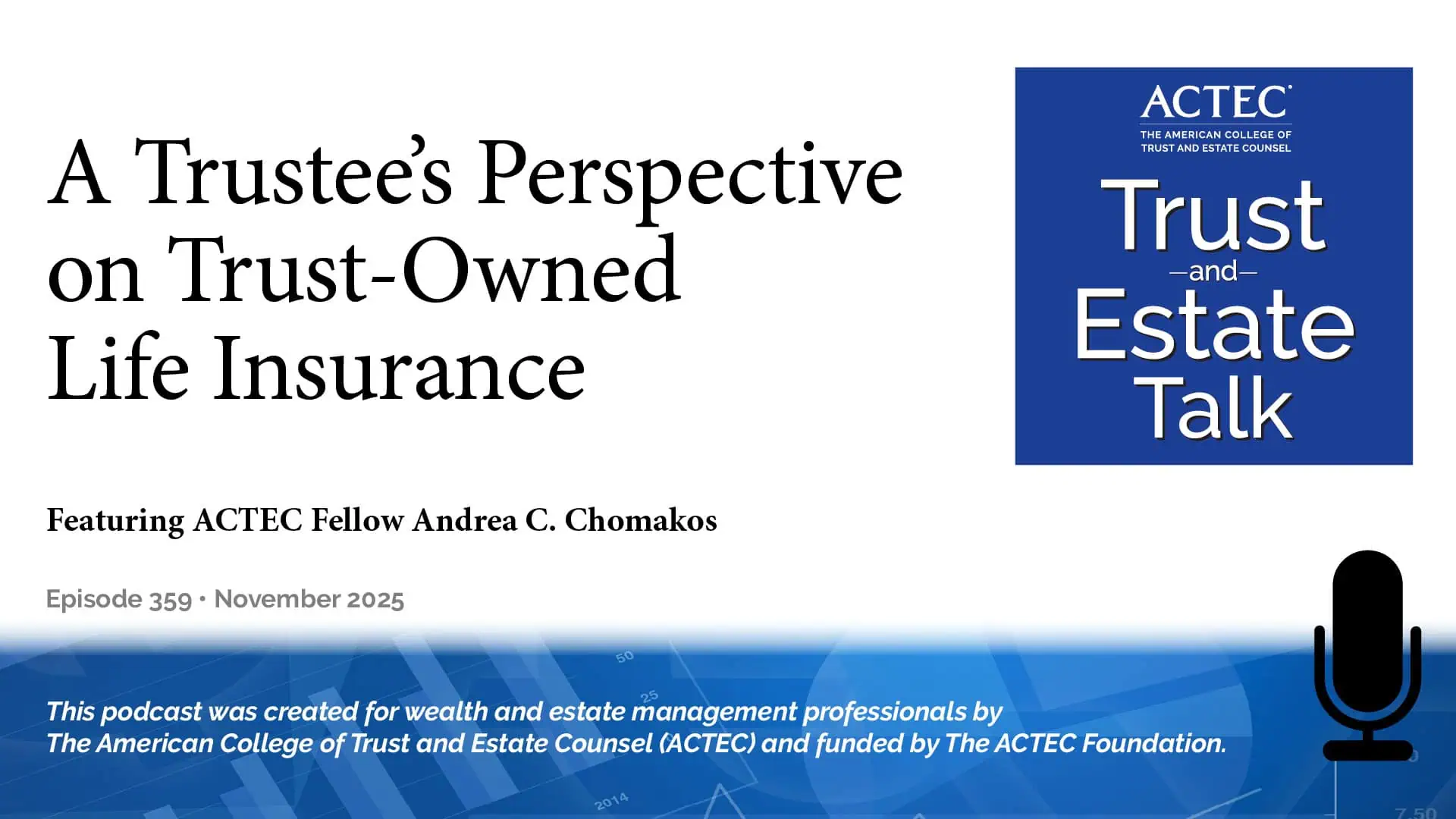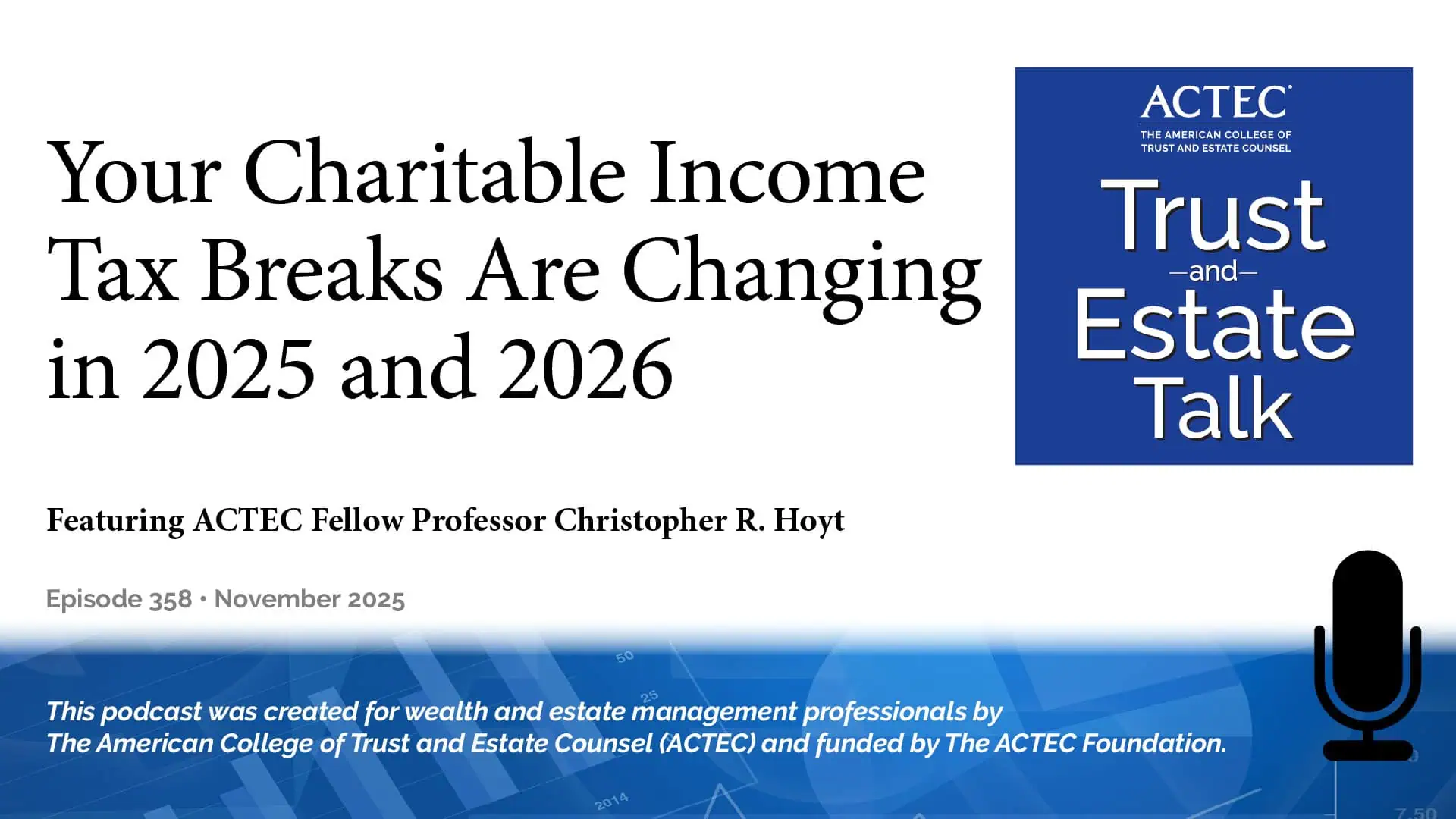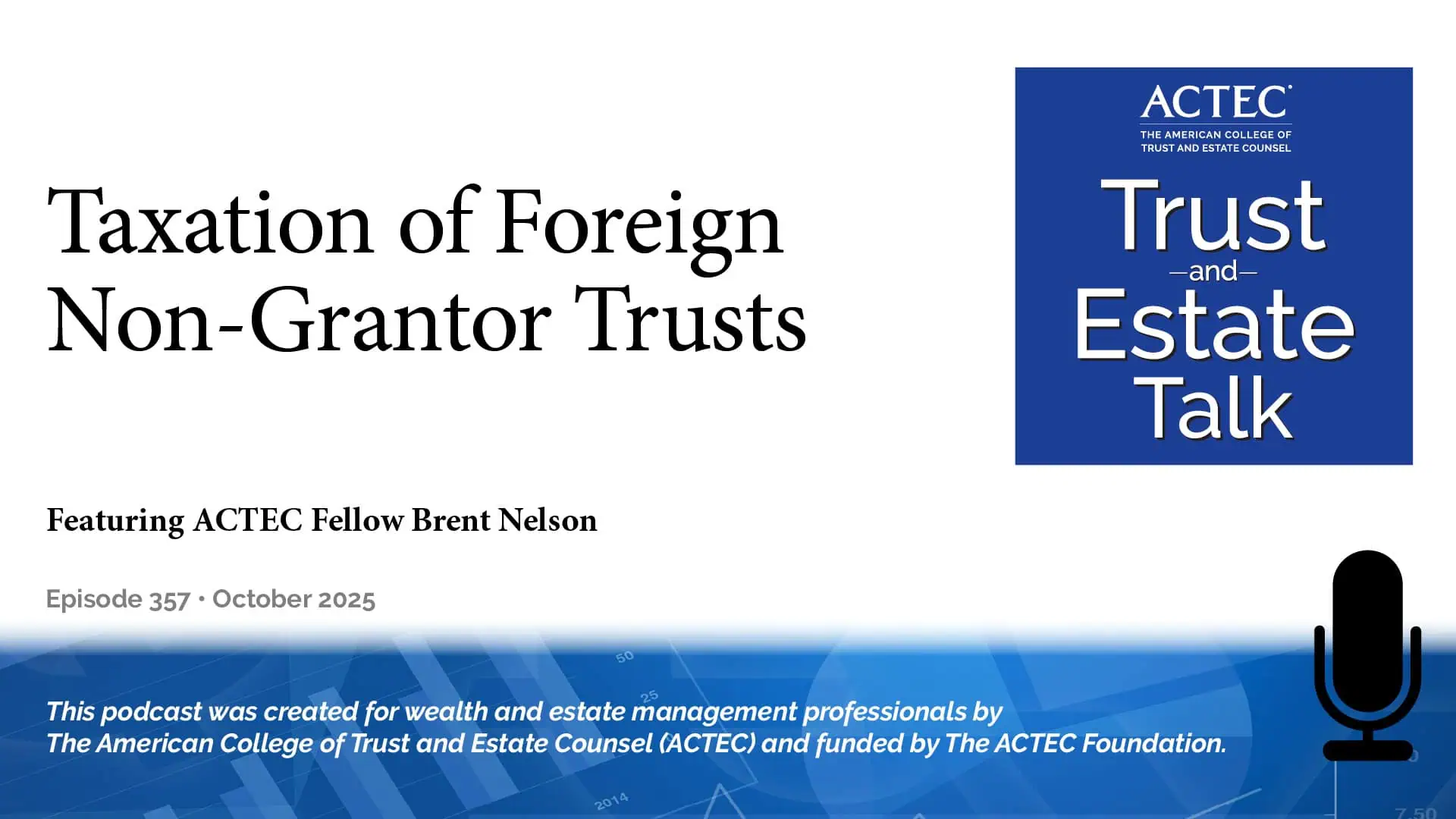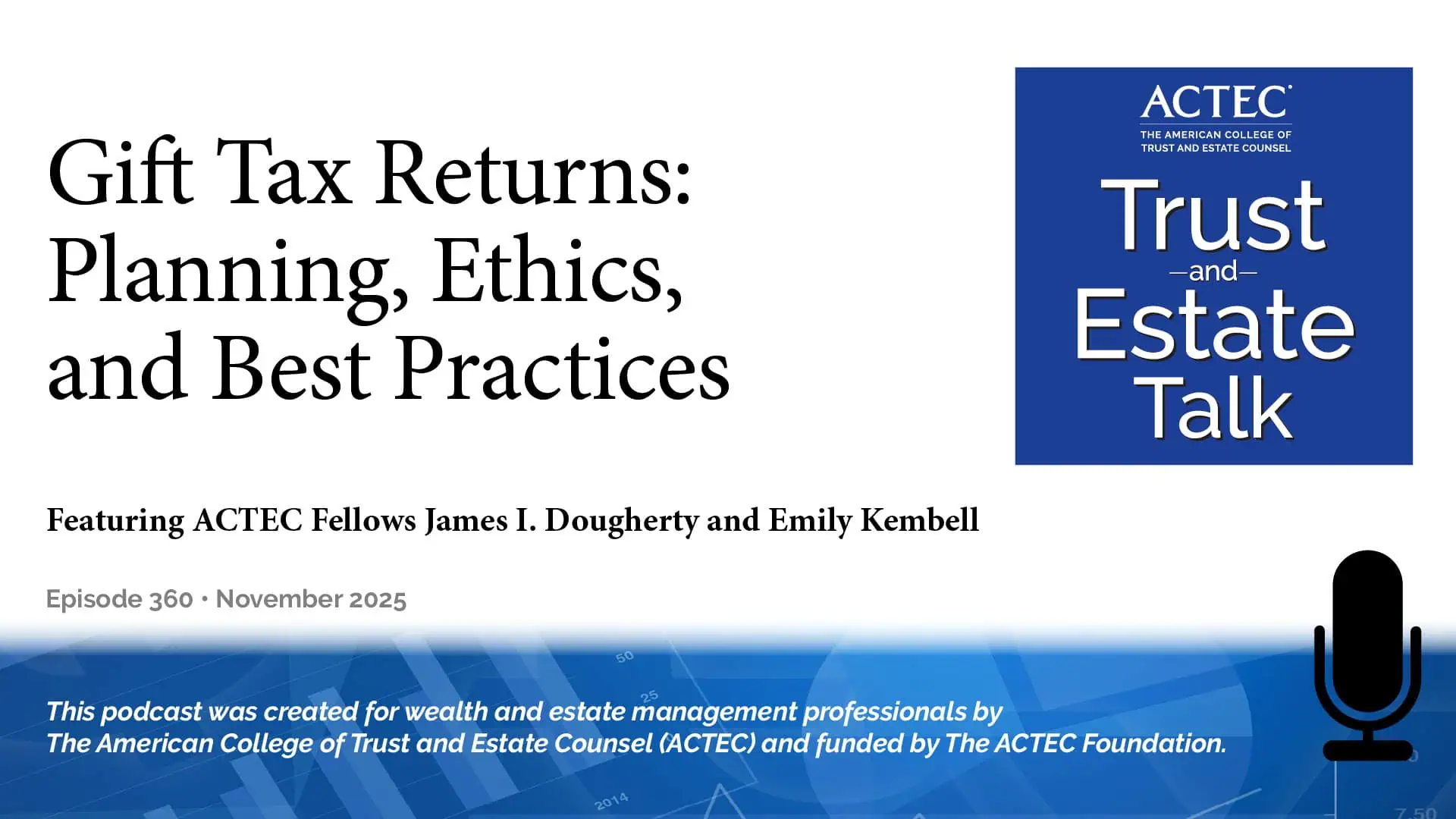Gift Tax Returns: Planning, Ethics, and Best Practices
“Gift Tax Returns, Planning, Ethics, and Best Practices,” that is the subject of today’s ACTEC Trust and Estate Talk.
Transcript/Show Notes
This is ACTEC Fellow John Challis of St. Louis, Missouri. Clients, advisors, and practitioners often focus on the planning and execution of transfers. However, without attention to the Gift Tax return filing, the intended results may not come to fruition.
ACTEC Fellows James Dougherty of Greenwich, Connecticut, and Emily Kembell of Springfield, Missouri, provide recent developments on Gift Tax reporting. Welcome, James and Emily.
Introducing Form 709-NA: Gifts by Non-Resident Aliens
Emily Kembell: Thank you, John. A whole new form now exists, Form 709-NA, which is used to report certain transfers by non-residents who are not citizens of the United States that are subject to the federal gift and certain generation skipping transfer taxes. And that form also assists to figure the tax due, if any, on those transfers, as well as to allocate generation skipping transfer tax exemption to property transferred during the transferor’s lifetime.
Someone who is considered a non-resident, not a citizen of the United States for these purposes, is a person who is a non-resident if that person is neither domiciled nor a citizen of the United States at the time the gift is made. A person who acquired U.S. citizenship solely by reason of being a citizen of a U.S. territory or by reason of birth or residence within a U.S. territory is not treated as a U.S. citizen.
Note that if a donor is a U.S. citizen or resident for part of the year and made a reportable gift during the tax year, that donor must report all gifts that he or she made during that year on form 709, not on the new Form 709-NA.
E-Filing Gift Tax Returns: Modernized E-File System
James Dougherty: We spend so much time as planners structuring the transaction and then working on the gift tax return, but how do we actually give it to the IRS? If we recorded this podcast a month ago, I’d be telling you that while many tax forms have an e-filing option, gift tax returns must still be paper filed. However, on July 14th, 2025, the IRS announced that it is possible to e-file gift tax returns through the modernized e-file or MEF system, effective immediately.
Now, we have known this has been coming for some time as the IRS has indicated that it was working on e-filing for gift tax returns as well as the estate tax returns with the expectation that the form 709 would be the first to be e-filed. However, we didn’t know exactly when it would happen and it was announced a few months after the April 15th deadline for reporting 2024 gifts.
E-filing certainly has its benefits. From a practitioner’s standpoint and I will appreciate not having to send large paper files and obtain proof of mailing when the MEF system allows for the filing to be paper free and provides proof of filing very quickly. Whether you want to move into the future and switch from paper filing to e-filing is up to you, but two things to consider that relate to the implementation of e-filing.
Practitioner Considerations: Software and Authorized E-File Providers
- First, some of you may not be able to do so at the moment because of your software program. As this just became live in July and so many 2024 returns were already filed, there are software providers who have made the decision not to implement the e-filing option on their software program until gift tax returns for the 2025 tax year. So check with your software provider.
- Second issue is that to e-file your clients, for your clients, you need to become an authorized e-file provider. Some of you may already be one because you prepare returns that have been able to be e-filed for some time. For those who aren’t though, you need to complete the IRS e-file application to become an authorized e-filer.
And now back to Emily with some updates on the 2024 tax return.
Gift Splitting Updates and Spousal Consent Procedures
Emily Kembell: Thanks, Jim. As we know, if a taxpayer or a taxpayer’s spouse made a gift to a third party, that gift can actually be considered as being made one half by each of them. Both spouses can apply the annual exclusion to one half of the gift. The donor spouse reports the gift on his or her gift tax return, but makes the election to gift split on part three of Form 709.
There is a new procedure for reporting split gifts. With this procedure, the consenting spouse no longer signs the donor spouse’s gift tax return. Rather, he or she must file what’s called a notice of consent, which includes a statement that he or she is electing to treat all gifts made to third parties as having been made one half by each spouse. In the event both spouses are required to file gift tax returns, each spouse should execute this notice of consent, and their returns must be filed together in the same envelope. The gift splitting election must be made on the first gift tax return for the year that’s filed by either spouse.
Digital Assets and Gift Tax: Reporting Cryptocurrency and NFTs
I’m now going to turn to an interesting issue regarding digital assets. We know now they’re everywhere, but we need to take notice of them when filing gift tax returns as well. The IRS has issued a couple of notices, the most recent in 2023, that provides that digital assets should be treated as property for federal tax purposes, which means gifts of digital assets are treated like gifts of other property for gift tax purposes. The instructions to Form 709 specifically address gifts of digital assets and state that the gift tax specifically applies to transfers of digital assets. Digital assets for this purpose are any digital representations of value that are recorded on a cryptographically secured distributed ledger or any similar technology. This would include things like virtual currencies, cryptocurrencies, and stable coins, for example. Jim, I’m going to hand it back over to you to discuss adequate disclosure rules.
Adequate Disclosure Rules: Statute of Limitations
James Dougherty: Great. Thanks, Emily. When filing a gift tax return, one of the things I’m most focused on is ensuring the transfers, whether it was a gift or non-gift being reported, were adequately disclosed in order to have the statute of limitations on the transfer run.
Now, as a brief history for transfers prior to August 6, 1997, the IRS was not barred by statute of limitations unless, 1) gift tax was actually paid, and 2) the IRS statute of limitations only applied to questions of value. Legal issues could still be revisited. Given gift and estate taxes are cumulative, that can inject some real uncertainty in the planning. Then comes the Taxpayer Relief Act of 1997 and that provides generally that there will be a three-year statute of limitation on transfers that were adequately disclosed.
But if this happened almost 30 years ago, why are we talking about it with recent developments? It’s because there has been such a dearth of guidance on this very important topic, both from the IRS as well as the courts, with the most substantial guidance only coming relatively recently from the U.S. tax court. So little guidance has come out, I can actually summarize it all up in just a few minutes, because the guidance really only covers three things.
- What issues cannot be adjusted after the expiration of statute of limitations.
- Whether a gift was adequately disclosed is a question of fact and what that means in practice.
- What needs to be provided to adequately disclose?
So first, what issues cannot be adjusted? As mentioned before, prior to the adequate disclosure, only valuation issues were settled, and only if a gift tax liability was paid. So if you say it under the exemption, valuation issues were fair game, and legal issues such as the validity of elections or whether a gift was complete was always an open question.
Now, once the statute of limitation runs, then neither the value or legal positions can be changed, regardless of whether tax was paid. The Treasury Regulations were amended to reflect this, and to give an example of legal questions in practice, there were three Private Letter Rulings from 2015 to 2017 dealing with split gift elections that were made that were invalid. And the IRS concluded that if the statute of limitations had not run, an adjustment could be made. However, if the statute of limitations did run, then it would be treated that the election was made, even if it was invalid when it was made.
Lessons from Tax Court Cases: Brown, Sanders, and Schlapfer
Now, the second thing we have learned — and this has come out of two tax court opinions — is whether you adequately disclose is a question of fact. These cases were the Estate of Brown in 2013 (Estate of Brown v. Commissioner, T.C. Memo. 2013-41) and the Estate of Sanders in 2014 (Estate of Hazel F. Hicks Sanders v. Commissioner, T.C. Memo. 2014-100). In both cases, the taxpayer made the argument that they adequately disclosed transfers, therefore the IRS could not adjust what was reported. In both cases, the IRS argued that the statute of limitations never started to run because the transfers and questions were not adequately disclosed. So no one disputed whether three years passed from the filing, it was whether the statute even started to run.
In both cases, the tax court denied the taxpayers’ motion for summary judgment because whether there was adequate disclosure was a question of fact, meaning both sides would need to present evidence and arguments on the point that determine if there was adequate disclosure. Ultimately, both cases settled after the summary judgment was denied, so we never got the answer in those cases to what adequate disclosure is.
Two lessons here:
- First is adequate disclosure isn’t just looking at a calendar and that the IRS can subject a taxpayer to examination with all the costs and time that comes with an audit. So don’t oversell the benefits of adequate disclosure as it’s a useful tool at our disposal, not a complete shield.
- Second lesson, when you get a client that’s previously filed gift tax returns, take a close look and make a determination of whether you believe the standard was met, advise the client accordingly, and consider amending the return in accordance with Revenue Procedure 2000-34 to adequately disclose and get the clock running for the statute of limitations.
The final question, the big question that we’ll deal with today on adequate disclosure is what do you have to do to adequately disclose? The regulations provide a standard, which is “a transfer will be adequately disclosed on the return only if it’s reported in a manner adequate to apprise the Internal Revenue Service, the nature of the gift, and the basis for the values so reported.” The regulations go on to provide what are two safe harbors that comply with this: one is the appraisal method, where an appraisal that meets certain requirements in the Regulations is submitted; and the other is the description method, where the taxpayer provides certain information set out in the regulations.
These Regulations came out in 1999, and in 2015, the IRS issued field of attorney advice 20152201F. This was regarding a return that I am not contending meets adequate disclosure. There was no appraisal for gift of a partnership interest to a trust, just a one-page statement. It got the name of the entities wrong, it had missing digits in the EIN for the partnerships, and it said there were discounts, but didn’t explain how they were determined. Bad facts make bad law, as a common saying when it comes to cases, and same thing with the IRS guidance here.
The field attorney advice had two positions that were concerning from the taxpayer perspective. First, it described the appraisal method and description method as the sole means of adequately disclosing rather than a safe harbors. Second, it showed a complete lack of onus on itself. For example, the IRS said it had no way of figuring out the correct EIN because of so many possible digit combinations. Here’s a potential solution, the IRS would just audit the taxpayer. If the IRS has enough information to know that the return is problematic and has errors, isn’t the solution to audit? And maybe here the errors were too pervasive to have it be adequately disclosed, but it raises the issue for all taxpayers.
Substantial vs. Strict Compliance: IRS and Tax Court Guidance
Is the standard strict compliance or substantial compliance? And that takes us to the recent development, which was the U.S. Tax Court opinion in the Estate of Schlapfer (Schlapfer v. Commissioner, T.C. Memo. 2023-65) in 2023. Here, the taxpayer made a gift of an insurance policy to his mother and other family members in 2006 and 2007, with the gift being actually completed for gift tax purposes in 2007. The gift was not reported timely, but instead is part of an offshore voluntary disclosure program in 2013, which reported it was a 2006 gift, even though it wasn’t completed until 2007. The OVDP program asked questions in 2014, which were responded to, and in 2016 there was a gift tax audit, in 2019 it noticed that deficiency was issued.
Unlike the Estate of Brown (Estate of Brown v. Commissioner, T.C. Memo. 2013-50) and the Estate of Sanders (Estate of Sanders v. Commissioner, T.C. Memo 2014-100), we get a decision on what adequate disclosure is. There were many specific issues argued about, but two big questions were answered. First, the court confirmed that the appraisal method and description method are safe harbors and not the sole means to meet adequate disclosure. Second, the standard is substantial compliance and not strict compliance. The court adopted its logic applied in income tax cases that reached this result, as well as pointing to the IRS’s response to the comments on the adequate disclosure regulations, where commentators said the regulation should make clear its substantial compliance. In response to those comments, at the time the IRS said it won’t put it in the regulations itself because it’s a hard concept to illustrate, which is fair enough, but the IRS wanted to say that a mistake won’t preclude adequate disclosure from applying, which the tax court in Schlapfer found is a quintessential explanation of what substantial compliance is.
So while adequate disclosure remains a question of fact, and it’ll depend on the facts of each case, we can feel good on the taxpayer side that Schlapfer sets the standard of substantial compliance.
Emily Kembell: Okay, thank you, Jim. It was a pleasure to present with you again today to talk about the gift tax return updates, and thanks again.
John Challis: Thank you, James and Emily, for a great presentation on gift tax returns.
You may also be interested in:
Latest ACTEC Trust and Estate Talk Podcasts

A Trustee’s Perspective on Trust-Owned Life Insurance
Learn key considerations for trustees managing Irrevocable Life Insurance Trusts (ILITs) and how to navigate grantor rules and withdrawal rights.

Your Charitable Income Tax Breaks Are Changing in 2025 and 2026
Learn how 2025–2026 tax changes impact charitable deductions, DAFs, and SALT limits, plus smart year-end giving and IRA gift strategies.

Taxation of Foreign Non-Grantor Trusts
Learn how U.S. tax rules affect foreign non-grantor trusts and discover key strategies for cross-border estate planning and compliance.



